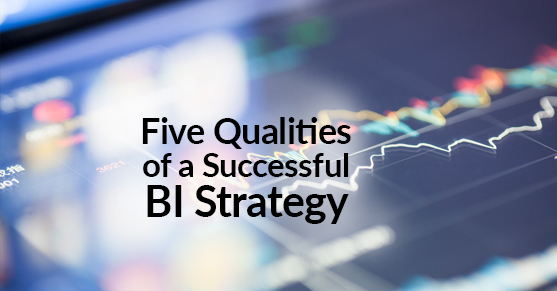Over the years, companies have continued to direct significant effort toward their BI solutions to help take their data and transform it into actionable insights. By correctly leveraging the data your business collects, BI solutions can play a pivotal role in advancing your organization toward continued success. However, too often is BI referred to as a tool that, once installed, can revolutionize the way your company does business — that’s only half the story. With every BI tool, there needs to be a BI strategy.
What is a BI Strategy?
When we’re talking about a BI strategy, we’re referring to the necessary steps and processes a business needs to introduce their organization to business intelligence. It encapsulates the entire journey from the conception of BI initiatives and internal assessment through identifying key performance indicators (KPIs) to help measure success. The BI strategy is born from taking your business’s vision, processes and architecture to develop a solution defined by your priorities and feasible goals.
Why do I need a BI Strategy?
As we mentioned earlier, a BI solution isn’t just the implementation of new software; it needs to be accompanied by a tactical strategy to guide your organization. Collecting data and customer information with your BI platform is all well and good, but without a business strategy, that data becomes stagnant, adding little to no business benefit. In other words, your team needs a roadmap to help your business navigate the process and help you meet your goals.
Five Aspects of a Successful BI Strategy
1) Define the State of Your Data
The first step in developing a successful BI strategy is figuring out where you are and where to improve your current BI resources. Although many companies have begun the journey with descriptive analytics, scheduled reports, ad hoc reporting, and other descriptive analytics, there’s so much more. With a proper BI strategy, your organization takes their analytics from a place of hindsight to a stage of advanced analytics (predictive and prescriptive). It’s imperative at the beginning of a BI journey to know where you are, so you can begin looking toward where you want to be.
2) Outline the Purpose of Your BI Strategy
Collecting data for the sake of collecting data is a fool’s gamble. Your new BI strategy needs to encompass an initiative of using data to benefit the company, that is, answering business-centered questions to steer your efforts. Here are a few examples:
- Are we looking to improve efficiency? Where?
- Are we trying to improve customer experience?
- Where can we add value to our solution and for which area of our organization?
Ask the questions you want your data to answer; they need to be specific questions with a purpose. With those questions directing your investigation, you can explore your data efficiently and effectively. Then, you’ll want to find the problem areas of your business and, we can’t stress this enough; be honest. An honest, accurate evaluation of your data weaknesses will only serve to help you in the long run. Maybe there are missing datasets your organization has failed to leverage as a piece of the puzzle. Recognizing your problem areas and addressing them will reinforce your strategy.
3) Define Data Communication and Consumption
Most of the time we’re talking about BI, we’re talking about gathering data, but too often companies forget to consider how they consume and disseminate that data. How will the new solution be communicated to users? Who will the users be? Who has access to specific dashboards and analytics? How will it be deployed across the organization? This also boils down to adoption. How will you be rolling out the new platform? What areas of your business will you be introducing it to first? How will you conduct the training?
It’s a lot of “soul-searching,” as you might call it, but the result is a detailed map of data consumption and access, which is vital to a successful BI strategy.
4) Scale Your Platform
BI tools come with a plethora of additional tools, but they’re not always a good fit for your organization. What you want to look for are tools that can provide your business with value. Decide which functions will help you solve your underlying problems, and which ones aren’t a good match for your company. Find which dashboards work at each level confirming who likes them. Once you have this step in place, remember to maintain consistent evaluations of the platform and user experience.
5) Scale Your Strategy
Like any business plan, time changes everything. The BI strategy you release today will not be the one that you rely on in five or ten years, which means evaluating your BI solution often is a crucial aspect of your strategy. Evaluate your tools, your software, integrations, your dashboards, visualization, data routes, data consumption methods, look into every nook and cranny of your BI platform, and see if there are any bottlenecks, any areas in need of improvement. You can always find new technology and policies to match the ever-changing needs of your business — explore, test, and optimize your solution.
Threefold Approach to BI
A well-thought-out and professionally implemented BI strategy is paramount to enhancing your organization with data-driven solutions. BI is a threefold experience between people, processes, and technology with strategy connecting them. Without a designated plan, business intelligence lends itself to little more than data collection without actionable insight.
A BI solution is not just a platform. It’s a strategy hosted by people and realized by the combined efforts of your team and their technology. If leveraging a successful BI strategy is something your organization is looking for, reach out to XTIVIA by commenting on this blog below, or you can contact us here.

